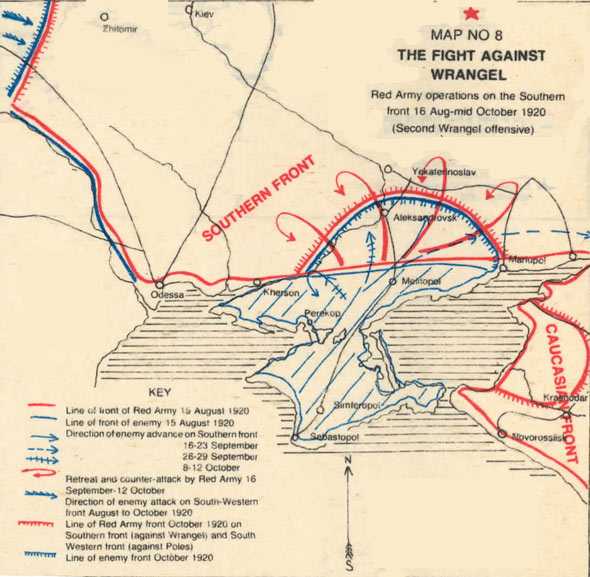Russian Civil War click here for the Wikipedia summary.
White Russians in Turkey click here for a related TNT
report.
//Ed. note: A Russian named Zerunof wrote a paper about
the SIGINT applications for wireless telegraphy in 1923.
A Turkish General Staff officer, Major Yakub, translated
the paper into Turkish and it was published by the
Training and Education Office of the Turkish General
Staff in 1927.
The maps below (recopied from the Russian ones and
translated into Ottoman Turkish) show the wireless
network of the forces of Pyotr Wrangel north of Crimea
(smaller map) and Wrangel's broader network (larger
map), based on intercepts made by the Bolshevik Red
Army opposing Wrangel, as described below by Zerunof:
"This map contains definite information about the positions of wireless
stations where Wrangel's army had moved to its farthest point of
advance north of Crimea. At that time, there were two of our wireless
location-fixing stations on the front that were able to provide precise
fixes of the enemy stations."

Toward the end of the Great War the situation regarding wireless
telegraphy had evolved and it played an important role in the
(Russian) Civil War, as well. The wide expanses and continuous
maneuvers related to the Civil War made the use of communications
means other than wireless impossible. Wireless stations were
only established at large detachments but played an important role,
since wire telegraphy was limited in capability. Wireless proved
itself during the large-scale cavalry and repulsion operations of
the Denikin and Wrangel battles.
In this paper we will show the degree reached by Western armies
vis-a-vis the evolution for military wireless telegraph nets and the
importance it has assumed. Now, an army can listen to all the points
that receive signals from a wireless transmitter in the battlefield
and keep track of the enemy's wireless stations' activities, conduct
surveillance and listen in. These operations have become know as
"wireless location-fixing and communications control".
The capability to conduct surveillance and fix the location of a
wireless station developed during the chaos of the Great War, although
the Russian Army lagged behind in this field. Consequently, when the
Civil War erupted, anyone with the requisite knowledge had been
discharged, the relevant documents had been destroyed and the Russian
Army had to start from scratch to confront the need to surveil foreign
wireless activity.

Map of the area around Crimea, for the sake of comparison.
//END of PART I//


Hiç yorum yok:
Yorum Gönder